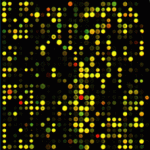Genomics
|
23 october 2014 16:50:33 |
| Gene expression patterns and sequence polymorphisms associated with mosquito resistance to Bacillus thuringiensis israelensis toxins (BMC Genomics) |
|
Tweet Background:
Despite the intensive use of Bacillus thuringiensis israelensis (Bti) toxins for mosquito control, little is known about the long term effect of exposure to this cocktail of toxins on target mosquito populations. In contrast to the many cases of resistance to Bacillus thuringiensis Cry toxins observed in other insects, there is no evidence so far for Bti resistance evolution in field mosquito populations. High fitness costs measured in a Bti selected mosquito laboratory strain suggest that evolving resistance to Bti is costly. The aim of the present study was to identify transcription level and polymorphism variations associated with resistance to Bti toxins in the dengue vector Aedes aegypti. We used RNA sequencing (RNA-seq) for comparing a laboratory-selected strain showing elevated resistance to Bti toxins and its parental non-selected susceptible strain. As the resistant strain displayed two marked larval development phenotypes (slow and normal), each phenotype was analyzed separately in order to evidence potential links between resistance mechanisms and mosquito life-history traits.
Results:
A total of 12,458 genes were detected of which 844 were differentially transcribed between the resistant and susceptible strains. Polymorphism analysis revealed a total of 68,541 SNPs of which 12,571 SNPs exhibited more than 40% frequency difference between the resistant and susceptible strains, affecting 2,953 genes. Bti resistance is associated with changes in the transcription level of enzymes involved in detoxification and chitin metabolism. Among previously described Bti-toxin receptors, four alkaline phosphatases (ALPs) were differentially transcribed between resistant and susceptible larvae, and non-synonymous changes affected the protein sequence of one cadherin, six aminopeptidases (APNs) and four alpha-amylases. Other putative Cry receptors located in lipid rafts, such as flotillin and glycoside hydrolases, were under-transcribed and/or contained non-synonymous substitutions. Finally, immunity-related genes showed contrasted transcription and polymorphisms patterns between the two developmental resistant phenotypes, suggesting the existence of trade-offs between Bti-resistance, life-history traits and immunity.
Conclusions:
The present study is the first to analyze the whole transcriptome of Bti-resistant mosquitoes by RNA-seq, shedding light on the importance of studying both transcription levels and sequence polymorphism variations to get a comprehensive view of insecticide resistance. |
| 105 viewsCategory: Genomics |
 SeAMotE: a method for high-throughput motif discovery in nucleic acid sequences (BMC Genomics) SeAMotE: a method for high-throughput motif discovery in nucleic acid sequences (BMC Genomics)Transcriptional and epigenetic responses to mating and aging in Drosophila melanogaster (BMC Genomics) 
|
| blog comments powered by Disqus |
MyJournals.org
The latest issues of all your favorite science journals on one page
The latest issues of all your favorite science journals on one page



